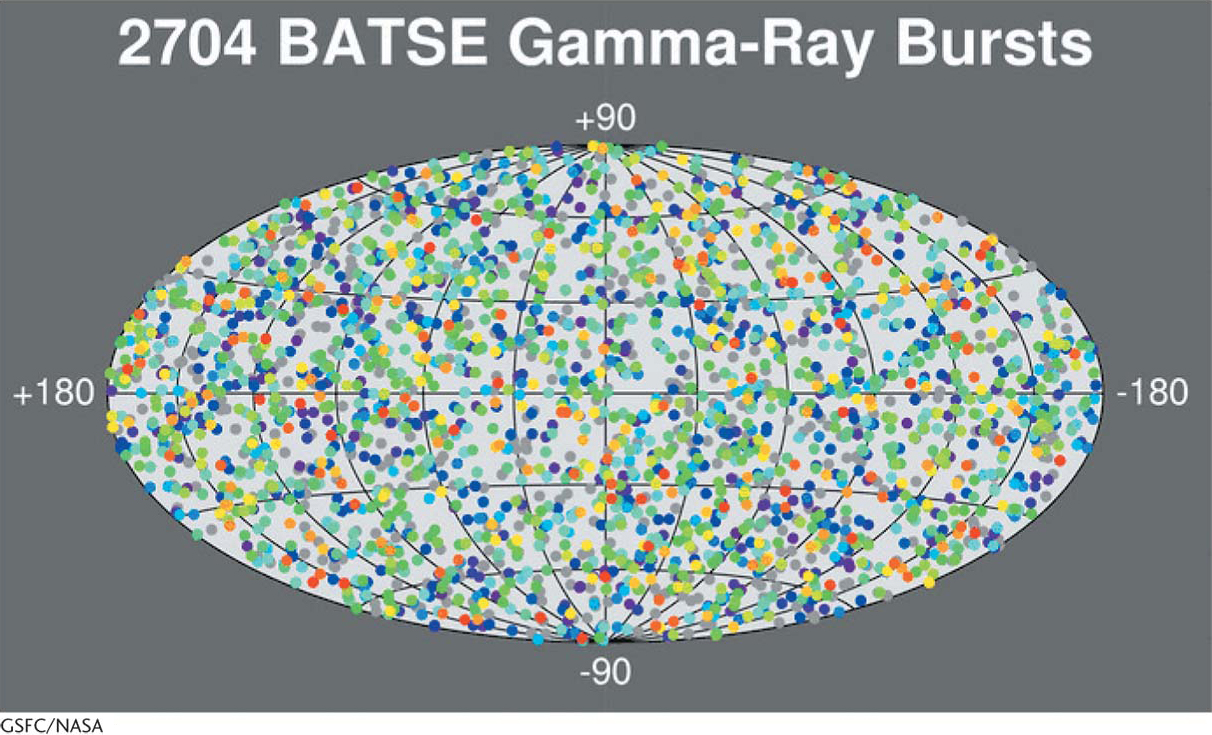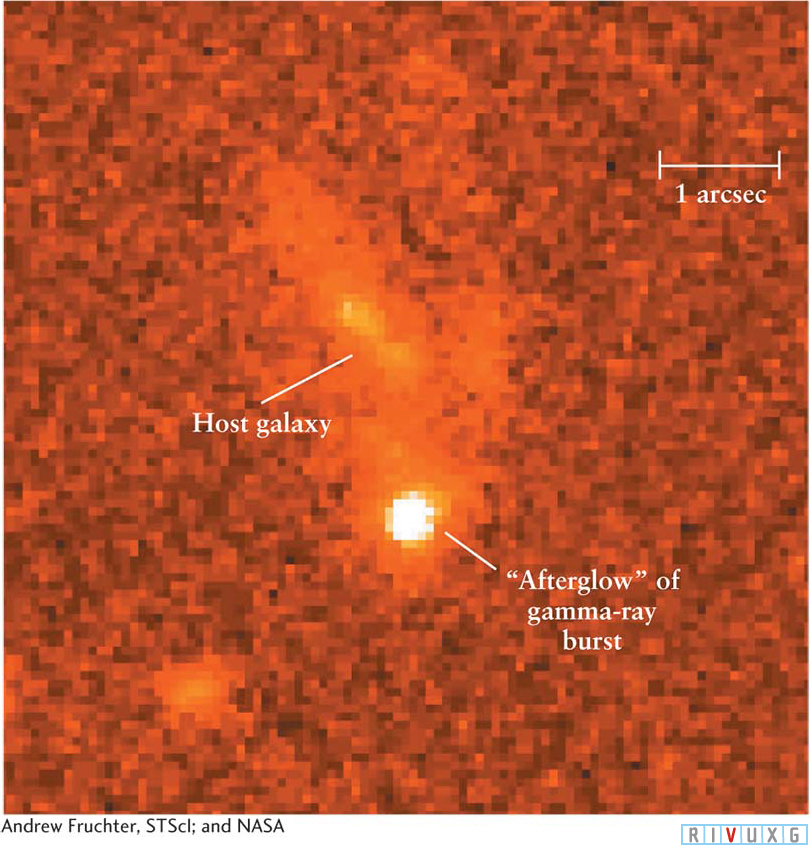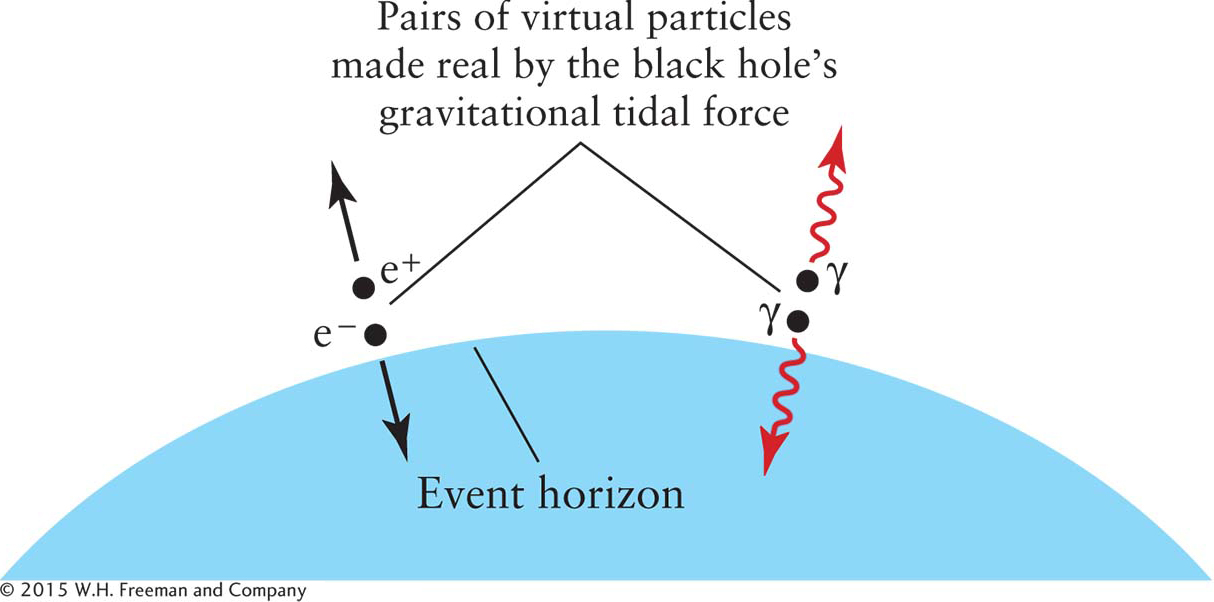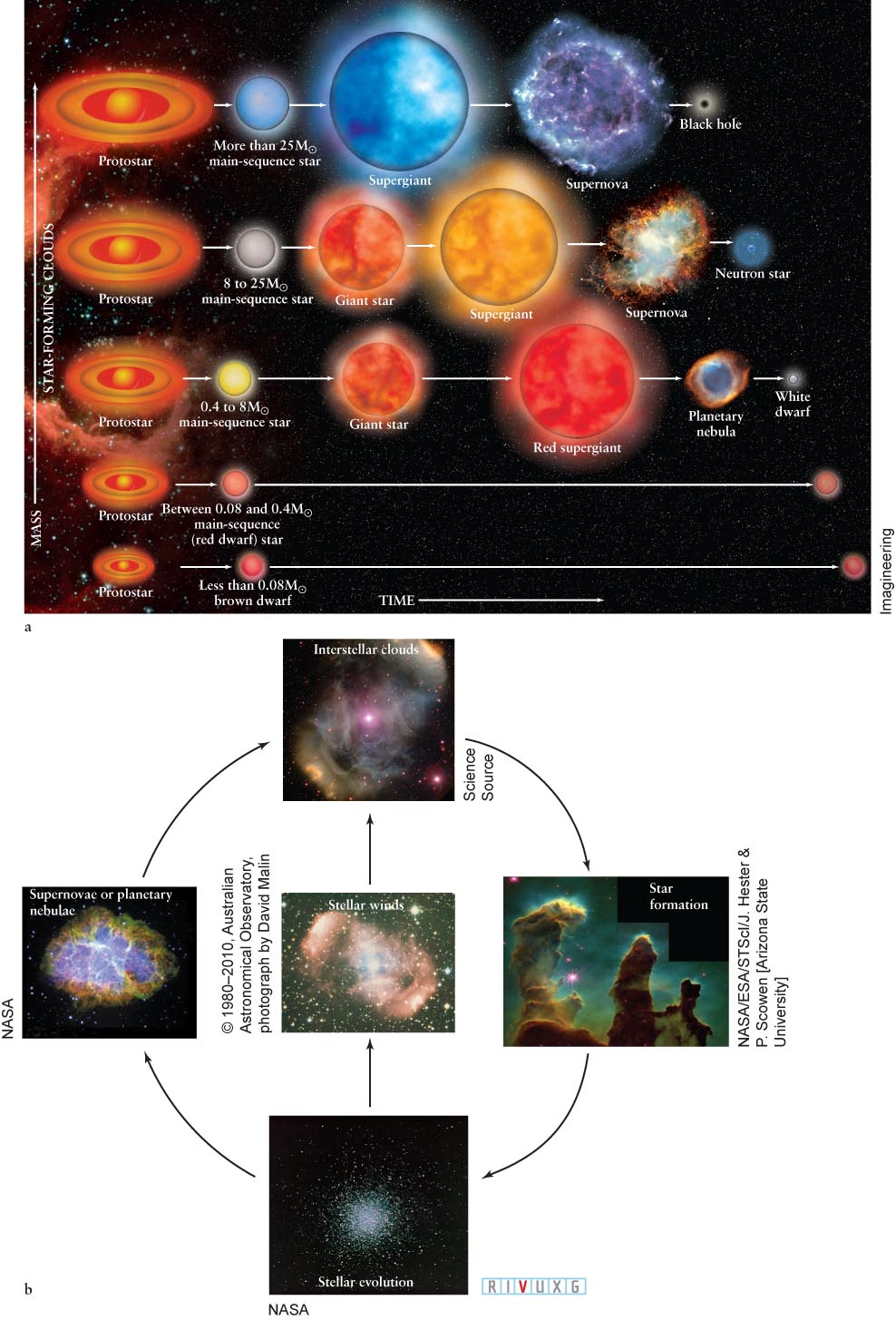12-17 Gamma-ray bursts are the most powerful explosions in the known universe
Because atomic bomb blasts emit pulses of gamma rays, the U.S. military put the gamma-ray-detecting Vela satellites in orbit around Earth to monitor illegal nuclear explosions in the 1960s. In 1973, astronomers were told that since 1967, these satellites had been detecting bursts of gamma rays from objects in space. This news intrigued the astronomical community because, at that time, there was no known mechanism to emit such radiation.
Gamma-ray bursts each last between a few milliseconds and about 1000 seconds (just over 16 minutes). There appear to be at least three types of such bursts. One group typically lasts for a few tenths of a second. The second group typically lasts for about 40 seconds. The third group appears to have properties of both of the first two groups; hence, it is called a hybrid gamma-ray burst. Unlike X-ray bursts (see Section 12-10), each gamma-ray burst occurs only once.
Focus Question 12-21
Why doesn’t all the gas in a black hole’s accretion disk enter the black hole?

Figure 12-47: The Most Powerful Known Bursts Gamma-ray bursts have been observed everywhere in the sky, indicating that, unlike X-ray bursters, most do not originate in the disk of the Milky Way Galaxy. This map of the entire sky “unfolded” onto the page shows 2704 bursts detected by the Burst and Transient Source Experiment (BATSE) aboard the Compton Gamma-ray Observatory. (The colors indicate the brightness of the bursts; they are coded brightest in red, dimmest in violet. Gray dots indicate incomplete information about the burst strength.)
In 2004, astronomers detected the first remnant of a gamma-ray burst that occurred in the Milky Way. In 2008, they observed a gamma-ray burst 7.5 billion light-years away that also emitted enough visible light to be (just barely) visible to the naked eye here on Earth. For comparison, it was as bright as the Triangulum Galaxy, which contains some 30 billion stars and is only 3 million light-years away. More than 5000 gamma-ray bursts have been observed, and more are being discovered at a rate of about one per day. Plotting their locations on the celestial sphere (Figure 12-47), astronomers have discovered that the shorter-lived bursts occur slightly more commonly in the plane of the Milky Way Galaxy than elsewhere, while the longer-lived ones occur randomly over the sky.
Since 1997, optical and infrared “afterglows” of many gamma-ray bursts have been detected (Figure 12-48). These often persist for days, allowing astronomers time to study their spectra in detail. Such observations reveal that the light has passed through intergalactic gas clouds. Combining this discovery with observations of the bursts’ spectra and redshifts reveals that the longer-lasting bursts typically originate more than 6 billion light-years away, far outside our Galaxy. The most distant gamma-ray burst observed so far occurred 13.1 billion light-years away. Many of the shorter bursts occur in more nearby galaxies. Taking their distance into account, a typical long-lived gamma-ray burst emits as much energy in 100 seconds as the Sun will emit over the 10 billion years that it will be on the main sequence. Gamma-ray burst afterglows emit 2.5 million times as much visible light as does the brightest supernova ever observed.

Figure 12-48:  Gamma-Ray Bursts In 1999, astronomers photographed the visible-light counterpart of a 100-second gamma-ray burst some 9 billion light-years away in the constellation Boötes. The times indicated are after the burst began.
Gamma-Ray Bursts In 1999, astronomers photographed the visible-light counterpart of a 100-second gamma-ray burst some 9 billion light-years away in the constellation Boötes. The times indicated are after the burst began.
Focus Question 12-22
How long do gamma-ray bursts last?
Deep-sky observations of some gamma-ray bursts have begun to show galaxies in the same locations where the bursts were discovered. As Figure 12-49 reveals, the bursts do not appear in the centers of their host galaxies. Likewise, the bursts in the plane of the Milky Way are not located near the galactic nucleus. These observations indicate that bursts are not associated with the supermassive black holes in the galactic cores. Research suggests that gamma-ray bursts are instead associated with stellar cataclysms.

Figure 12-49:  The Host Galaxy of a Gamma-Ray Burst The Hubble Space Telescope recorded this visible-light image in 1999, 16 days after a gamma-ray burst was observed at this location. The image (color-coded to show contrast, rather than true color) reveals a faint galaxy that is presumed to be the home of the gamma-ray burst. The galaxy actually has a bright blue color, indicating the presence of many young stars.
The Host Galaxy of a Gamma-Ray Burst The Hubble Space Telescope recorded this visible-light image in 1999, 16 days after a gamma-ray burst was observed at this location. The image (color-coded to show contrast, rather than true color) reveals a faint galaxy that is presumed to be the home of the gamma-ray burst. The galaxy actually has a bright blue color, indicating the presence of many young stars.
In 2003, observations by NASA’s High-Energy Transient Explorer observed a 30-second gamma-ray burst that was seen to occur at the same place as a particularly powerful supernova, called a hypernova, occurring in Wolf-Rayet stars. These are rotating stars of at least 20 M⊙ with strong magnetic fields and stellar winds. The bursts associated with these stars occur when gamma rays and a lot of gas are funneled out along the rotation axis of the star prior to its exploding. If we are looking down the axis from Earth, the gamma rays create the burst, and the gas, traveling more slowly, creates the subsequent afterglow. Observations reveal that hypernovae and their associated gamma-ray bursts are extremely messy affairs, with powerful aftershocks, rather than a single, smooth outburst. Because gamma-ray bursts associated with supernovae occur near the beginning of these events, the bursts enable astronomers to watch the supernovae unfold, providing further insights into these explosions and the mechanism by which they generate gamma-ray bursts.
Other gamma-ray bursts occur when black holes collide, when a black hole swallows a neutron star, or when a pair of neutron stars collide and form a black hole. Observations made in 2005 confirm calculations predicting that the collision of such pairs of objects each lead to a rapid, intense burst of gamma rays.
To better understand gamma-ray bursts, astronomers have constructed telescopes for use both on Earth and in orbit that are able to rapidly slew (change direction) to look in the direction in which these events occur in space. These telescopes, including the Swift Gamma-Ray Burst Mission and the High Energy Transient Explorer 2, see these bursts and provide new insights into their origins and dynamics. Swift carries not only a gamma-ray telescope to locate the bursts but also separate X-ray and optical telescopes to study their afterglows.
12-18 Black holes evaporate
In exploring the fate of black holes, astrophysicists find that, once again, these objects confound common sense—they evaporate! With a black hole cloaked behind the event horizon and its mass collapsed into a singularity, it must seem that there is no way of getting mass from the black hole back out into the universe again. No way, that is, until you recall that mass and energy are two sides of the same coin. What if there was a way of converting the black hole’s mass into a form of energy that could get out, such as gravitational energy? The transformation does occur, according to an idea first proposed by Stephen Hawking.
Black holes convert their mass into energy by a process called virtual particle production. If things in this chapter aren’t weird enough, consider this: The laws of nature allow pairs of particles, called virtual particles, to spontaneously appear. Each pair consists of a particle and its antiparticle—such as a proton and an antiproton, an electron and an antielectron (positron), or a pair of photons. The particles in each pair are identical, except for having opposite electric charges, and they annihilate each other and normally disappear without a trace within a very short period of time, typically 10−21 seconds. Calculations reveal that billions and billions of pairs of virtual particles are seething in and out of existence in your body (and every other equivalent volume of space) every second.
We know that virtual particles actually flash into existence spontaneously throughout the universe because some have been made into real particles in the laboratory. This creation is done using high-speed particles in particle accelerators that slam into the pair of virtual particles and push them apart before they annihilate each other. The mass or energy given to the virtual particles in making them real comes from the laboratory particles, which lose an equal amount of energy.
Now, suppose two virtual particles form just outside the event horizon of a black hole. They would experience an exceptionally powerful gravitational field. If one particle is created slightly farther from the hole than its companion, the two virtual particles feel a tidal force from the black hole’s tremendous gravitational pull. If the gravitational tidal force is strong enough, it can pull the two virtual particles apart before they can annihilate each other. This separation makes them real (Figure 12-50).

Figure 12-50: Evaporation of a Black Hole Throughout the universe, pairs of virtual particles spontaneously appear and disappear so quickly that they do not violate any laws of nature. The tidal force just outside the event horizon of a black hole is strong enough to tear apart two virtual particles that appear there before they destroy each other. The gravitational energy that goes into separating them makes them real and, therefore, permanent. At least one of each pair of newly created particles falls into the black hole. Sometimes the other particle escapes into the universe. Here, we see just a few particles in the making: an electron (e−), a positron (e+), and a pair of photons (γ).
 To conserve momentum, at least one of the newly formed real particles always falls into the black hole. But the other particle will sometimes have enough kinetic energy to escape from the vicinity of the black hole. This latter particle flies free into space. Because the gravitational energy used to make the virtual particles real came from the mass of the black hole, the hole loses mass equal to E = mc2, where m is the mass of the freed particle and c is the speed of light or, if the pair of particles are photons, E = hc/λ, where λ is the wavelength of the departing photon and h is Planck’s constant. The energy from inside the black hole is transmitted outside the event horizon as gravitational radiation to replace the energy taken away by the newly formed particles. This is called the Hawking process, and the particles leaving the vicinity of the black hole are called Hawking radiation (even though many of the particles are not electromagnetic radiation). As a result of the Hawking process, the black hole loses mass—it evaporates.
To conserve momentum, at least one of the newly formed real particles always falls into the black hole. But the other particle will sometimes have enough kinetic energy to escape from the vicinity of the black hole. This latter particle flies free into space. Because the gravitational energy used to make the virtual particles real came from the mass of the black hole, the hole loses mass equal to E = mc2, where m is the mass of the freed particle and c is the speed of light or, if the pair of particles are photons, E = hc/λ, where λ is the wavelength of the departing photon and h is Planck’s constant. The energy from inside the black hole is transmitted outside the event horizon as gravitational radiation to replace the energy taken away by the newly formed particles. This is called the Hawking process, and the particles leaving the vicinity of the black hole are called Hawking radiation (even though many of the particles are not electromagnetic radiation). As a result of the Hawking process, the black hole loses mass—it evaporates.
Focus Question 12-23
Why does at least one particle in the Hawking process always fall into the black hole?
The time it takes a black hole to completely evaporate by the Hawking process increases with the mass of the hole. More massive black holes have lower tidal forces at their event horizons than do less massive and, therefore, smaller-diameter black holes. Therefore, the rate at which virtual particles are converted into real particles around bigger black holes is actually slower than it is around smaller ones. The faster the real particles are produced, the faster they wear down the mass of the black hole; thus, lower-mass black holes evaporate more rapidly than higher-mass black holes. Indeed, calculations indicate that in its final moments of evaporation, a black hole should create particles so quickly that it should appear to explode.
A stellar black hole of 5 M⊙ would take more than 1062 years to evaporate (much longer than the present age of the universe), whereas a 1010 kg primordial black hole (equivalent to the mass of Mount Everest) would take only about 15 billion years to evaporate. Since the universe is about 13.8 billion years old, a black hole of this size and age is well on its way to completely evaporating. Astronomers are trying to identify events in space that correspond to the violent, particle-generating deaths of primordial black holes.
Figure 12-51 summarizes the evolutionary history of stars.

Figure 12-51:  A Summary of Stellar Evolution (a) The evolution of isolated stars depends primarily on their masses: the higher the mass, the shorter the lifetime. Stars less massive than about 8 M⊙ can eject enough mass to become white dwarfs. High-mass stars can produce Type II supernovae and become neutron stars or black holes. The horizontal (time) axis is not to scale, but the relative lifetimes are accurate. (b) The cycle of stellar evolution is summarized in this figure.
A Summary of Stellar Evolution (a) The evolution of isolated stars depends primarily on their masses: the higher the mass, the shorter the lifetime. Stars less massive than about 8 M⊙ can eject enough mass to become white dwarfs. High-mass stars can produce Type II supernovae and become neutron stars or black holes. The horizontal (time) axis is not to scale, but the relative lifetimes are accurate. (b) The cycle of stellar evolution is summarized in this figure.


 Gamma-
Gamma-
 The Host Galaxy of a Gamma-
The Host Galaxy of a Gamma-
 To conserve momentum, at least one of the newly formed real particles always falls into the black hole. But the other particle will sometimes have enough kinetic energy to escape from the vicinity of the black hole. This latter particle flies free into space. Because the gravitational energy used to make the virtual particles real came from the mass of the black hole, the hole loses mass equal to E = mc2, where m is the mass of the freed particle and c is the speed of light or, if the pair of particles are photons, E = hc/λ, where λ is the wavelength of the departing photon and h is Planck’s constant. The energy from inside the black hole is transmitted outside the event horizon as gravitational radiation to replace the energy taken away by the newly formed particles. This is called the Hawking process, and the particles leaving the vicinity of the black hole are called Hawking radiation (even though many of the particles are not electromagnetic radiation). As a result of the Hawking process, the black hole loses mass—
To conserve momentum, at least one of the newly formed real particles always falls into the black hole. But the other particle will sometimes have enough kinetic energy to escape from the vicinity of the black hole. This latter particle flies free into space. Because the gravitational energy used to make the virtual particles real came from the mass of the black hole, the hole loses mass equal to E = mc2, where m is the mass of the freed particle and c is the speed of light or, if the pair of particles are photons, E = hc/λ, where λ is the wavelength of the departing photon and h is Planck’s constant. The energy from inside the black hole is transmitted outside the event horizon as gravitational radiation to replace the energy taken away by the newly formed particles. This is called the Hawking process, and the particles leaving the vicinity of the black hole are called Hawking radiation (even though many of the particles are not electromagnetic radiation). As a result of the Hawking process, the black hole loses mass—
 A Summary of Stellar Evolution (a) The evolution of isolated stars depends primarily on their masses: the higher the mass, the shorter the lifetime. Stars less massive than about 8 M⊙ can eject enough mass to become white dwarfs. High-
A Summary of Stellar Evolution (a) The evolution of isolated stars depends primarily on their masses: the higher the mass, the shorter the lifetime. Stars less massive than about 8 M⊙ can eject enough mass to become white dwarfs. High-